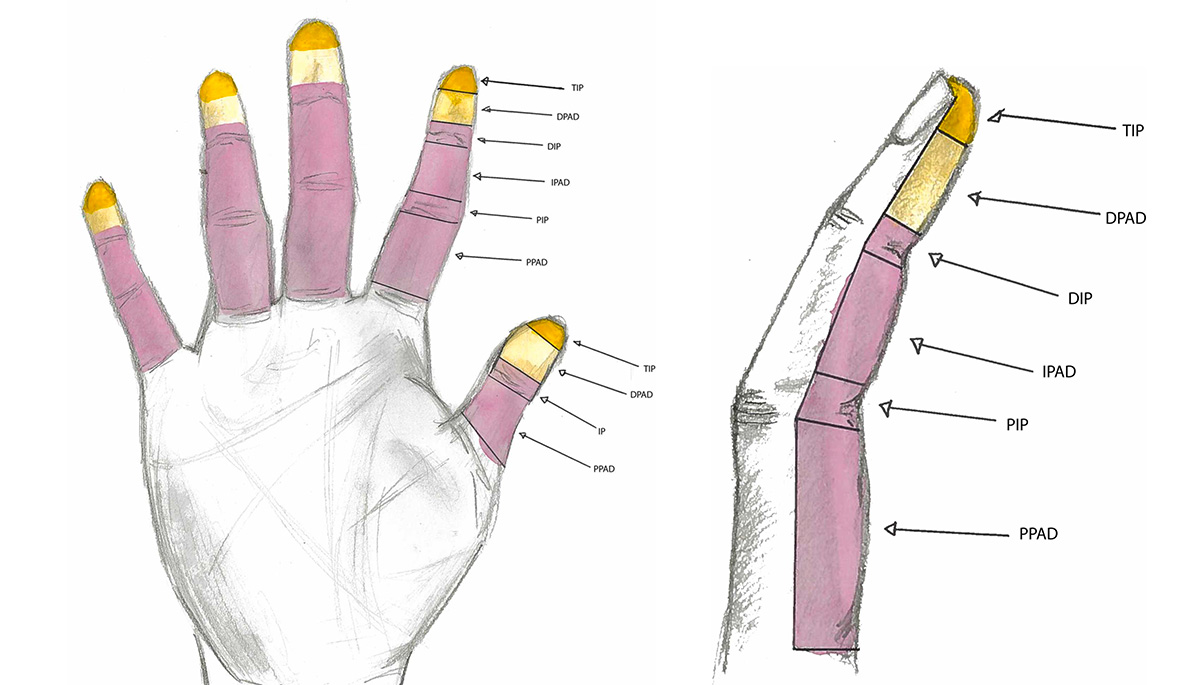News
Why Sense of Touch Varies Among Individuals
May 6, 2022
At left is a palmar view of the hand, with skin regions that were sampled and analyzed labeled: TIP (fingertip), DPAD (distal finger pad), DIP (skin over distal interphalangeal joint), IPAD (intermediate finger pad), PIP (skin over proximal interphalangeal joint), and PPAD (proximal finger pad). Note that regions sampled from digit #1 include only the TIP (fingertip), DPAD (distal finger pad), IP (skin over interphalangeal joint), and PPAD (proximal finger pad). The illustration at right, shows the lateral view of the finger, with the skin regions that were sampled and analyzed labeled: TIP (fingertip), DPAD (distal finger pad), DIP (skin over distal interphalangeal joint), IPAD (intermediate finger pad), PIP (skin over proximal interphalangeal joint), and PPAD (proximal finger pad). Illustrations by Joseph Ciano.
New anatomy research from the College of Osteopathic Medicine (NYITCOM) may explain why some individuals are more sensitive to tactile sensations than others.
As one of the five senses, touch allows the human brain to collect sensory data about the external environment, with specialized nerve receptors detecting different sensations. For example, while some nerve receptors in the fingers detect pressure, others sense temperature or pain. Meissner’s corpuscles are specialized receptors that detect light touch and pressure in the fingers, providing the acute sensitivity to read Braille text, play piano, and grip objects, among other tactile activities.
While some people are more sensitive to tactile sensory cues than others, little is known about how the distribution of Meissner’s corpuscles vary between individuals, fingers on the same hand, or even the different regions of the fingers themselves. In addition, body donor studies that thoroughly sample the distribution of Meissner’s corpuscles in the hand are extremely rare, and studies in living people utilize less invasive techniques, such as biopsy, which have limited accuracy.
A new study published in the Annals of Anatomy, authored by evolutionary biologist Brian Beatty, Ph.D., associate professor of anatomy, and NYITCOM alumnus Joseph Ciano (D.O. ’16), suggests that variations in the distribution of Meissner’s corpuscles may explain why some people are more sensitive to tactile sensory cues.
Under a microscope, the researchers analyzed skin tissue from the right hand of 16 cadavers. Ciano, who was a student at the time of the research, documented the number of Meissner’s corpuscles present in each finger, finger region (based on distance from the palm), and total number in each individual’s hand.
While the number of Meissner’s corpuscles varied little between fingers on the same hand, the fingertips had significantly higher quantities than other regions, such as the finger pads or interphalangeal joints. In addition, the number varied greatly between individuals, suggesting that those with more receptors may have exhibited greater tactile sensitivity, which would have been advantageous for activities such as playing the piano or sculpting art. In contrast, those with fewer Meissner’s corpuscles may have exhibited less tactile discernment, which could have impacted their grip and dexterity.
Ciano, who is now an attending emergency medicine physician at Northwell Health, also suggests that this insight could inform the diagnostic capabilities of healthcare providers who rely on hands-on techniques. This includes doctors of osteopathic medicine (D.O.), who utilize a therapeutic technique called osteopathic manipulative medicine, which relies on the application of manual pressure or force.
“Having more Meissner’s corpuscles in the fingers may be advantageous to D.O.s and other healthcare professionals who use palpation to clinically examine and treat patients, as it could enable them to feel subtle differences in the body,” notes Ciano.
Beatty adds that the findings also speak to how modern medicine and other societal factors have helped expand the neurodiversity of the human species.
“Theoretically, one would think that evolution would favor those individuals with a greater number of Meissner’s corpuscles. However, the variation we see in today’s humans suggests that, due to advancements in science and medicine or other external factors, individuals with fewer receptors may have been saved from natural selection,” he says.
As a next step, the researchers propose additional investigations with larger study populations that examine whether the number of Meissner’s corpuscles and distribution vary by hand size.





